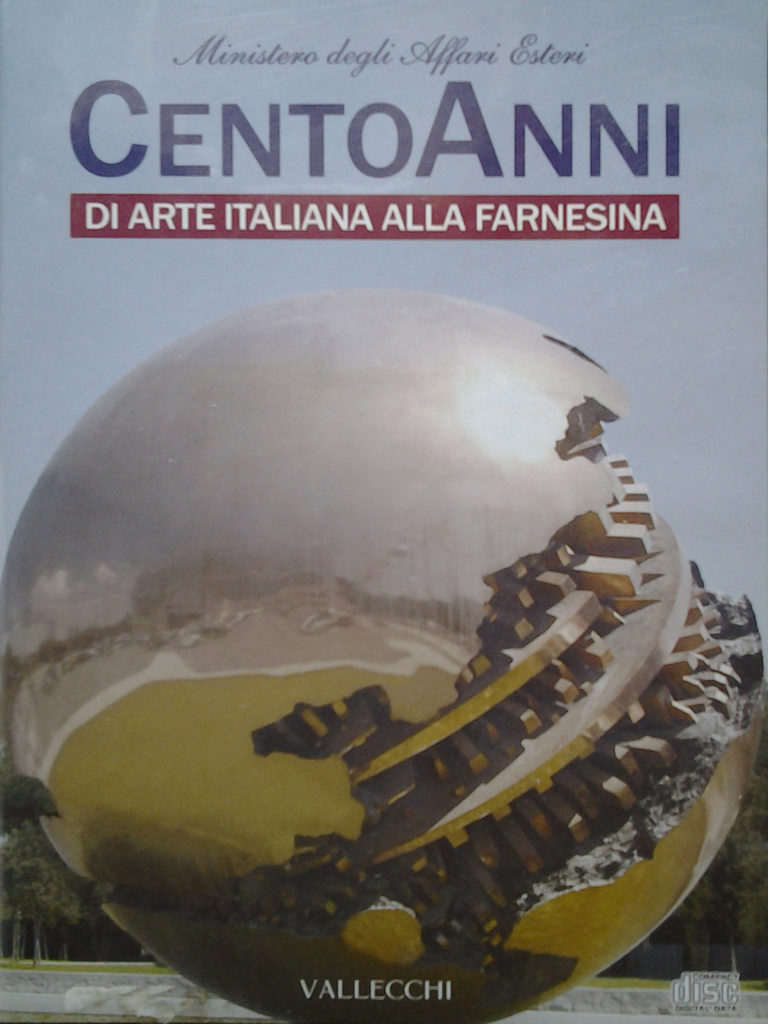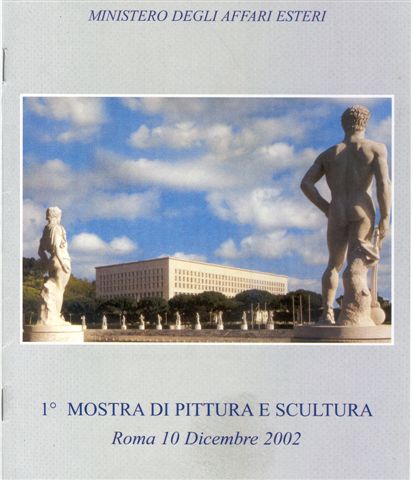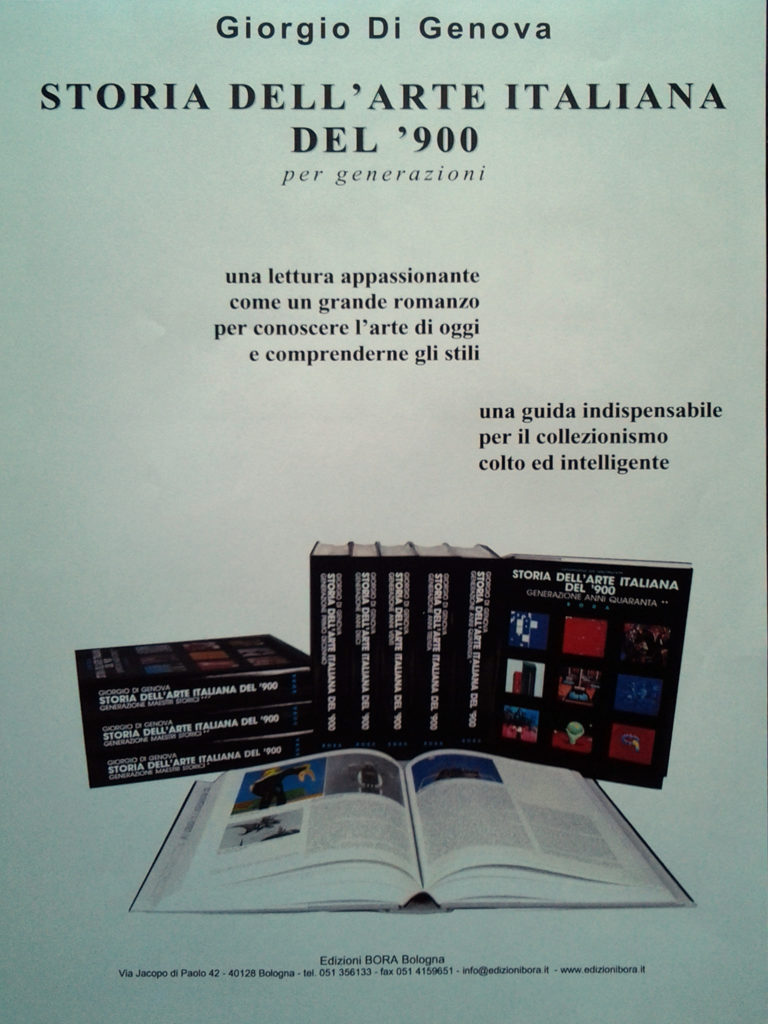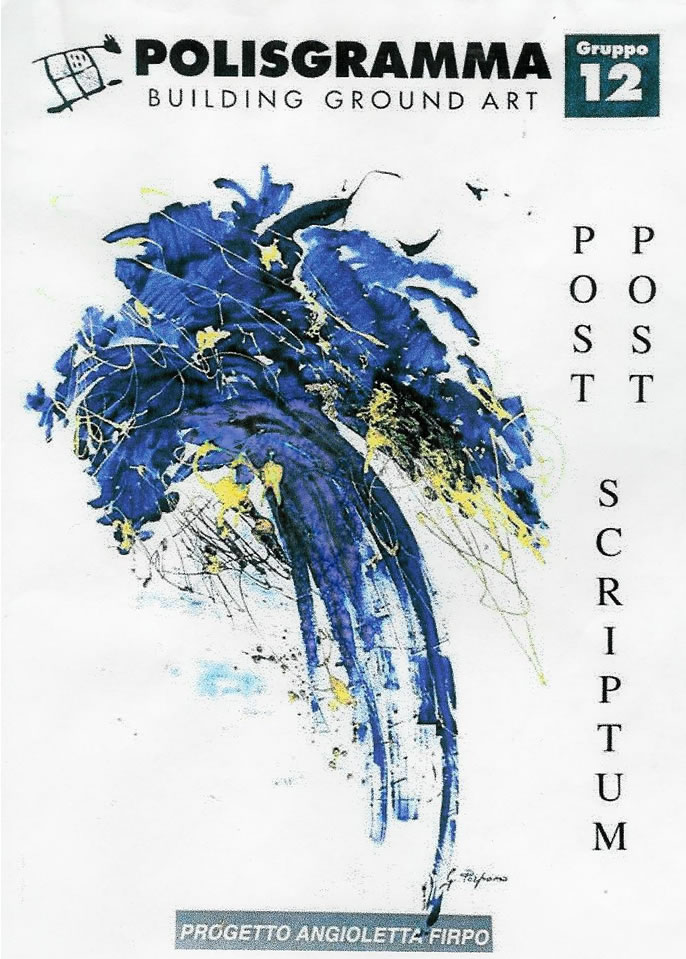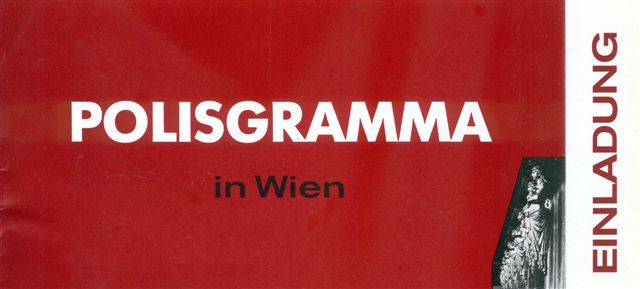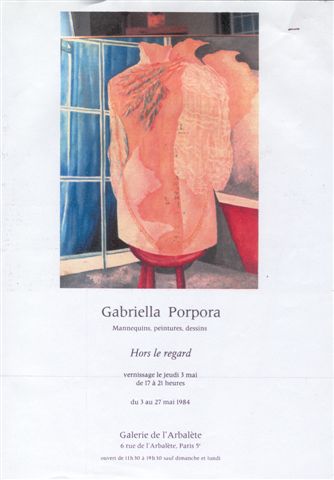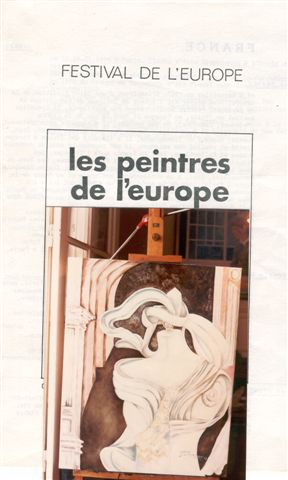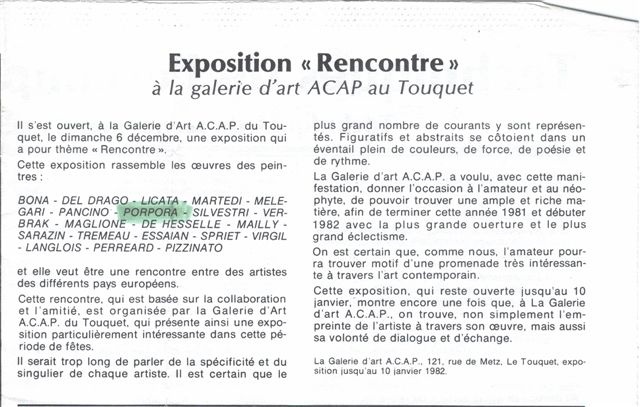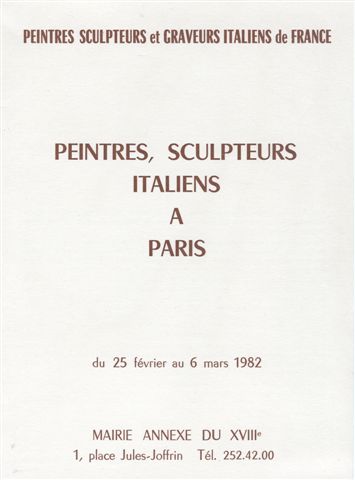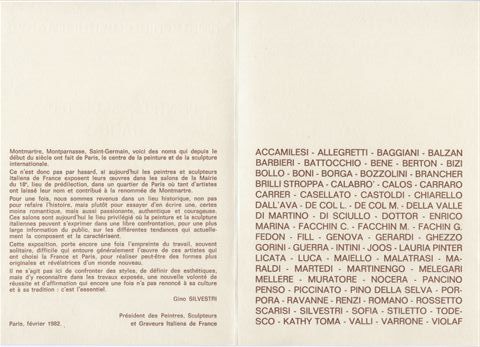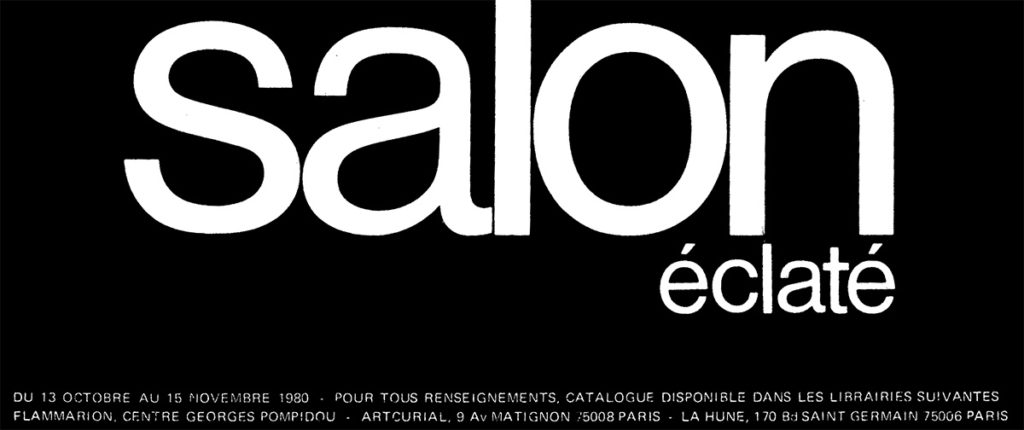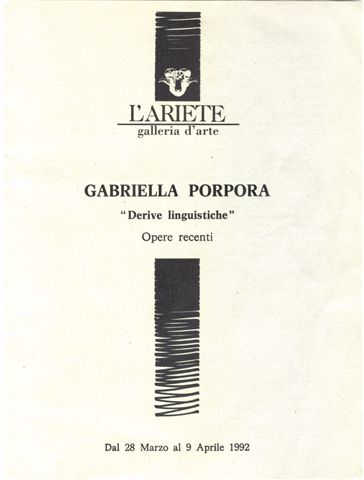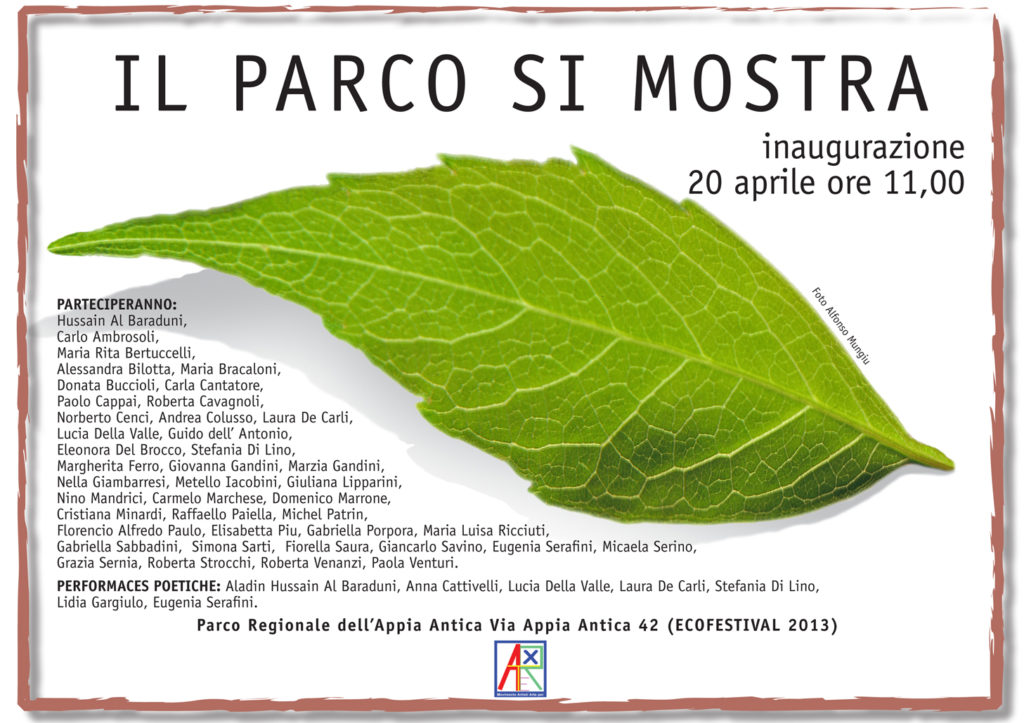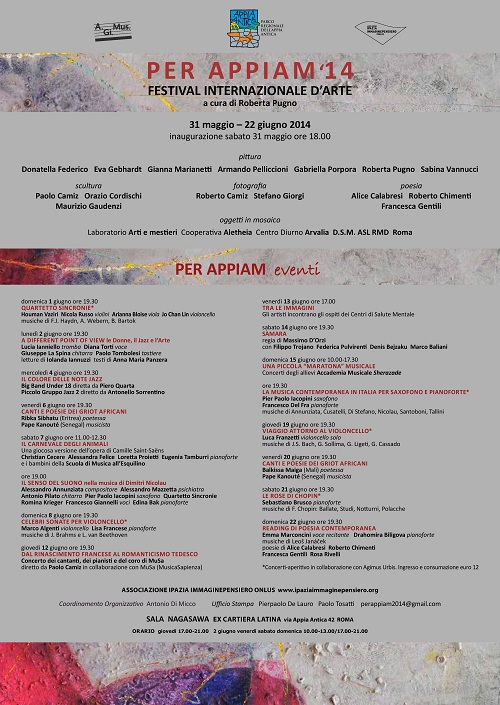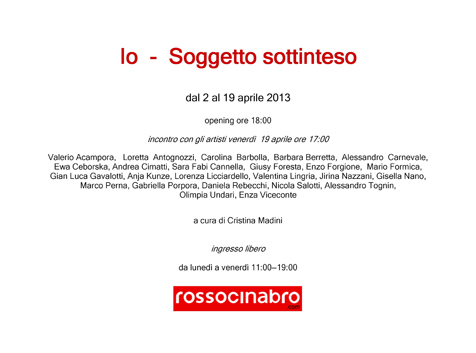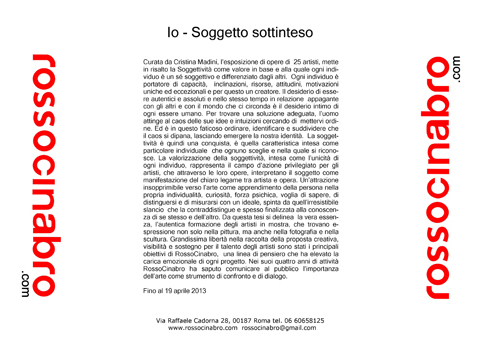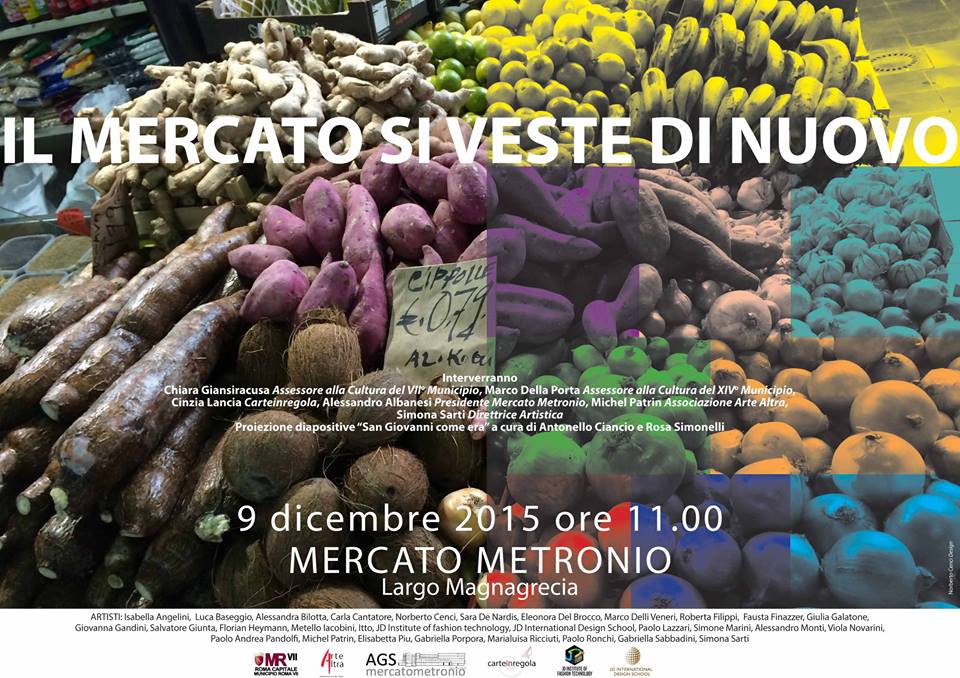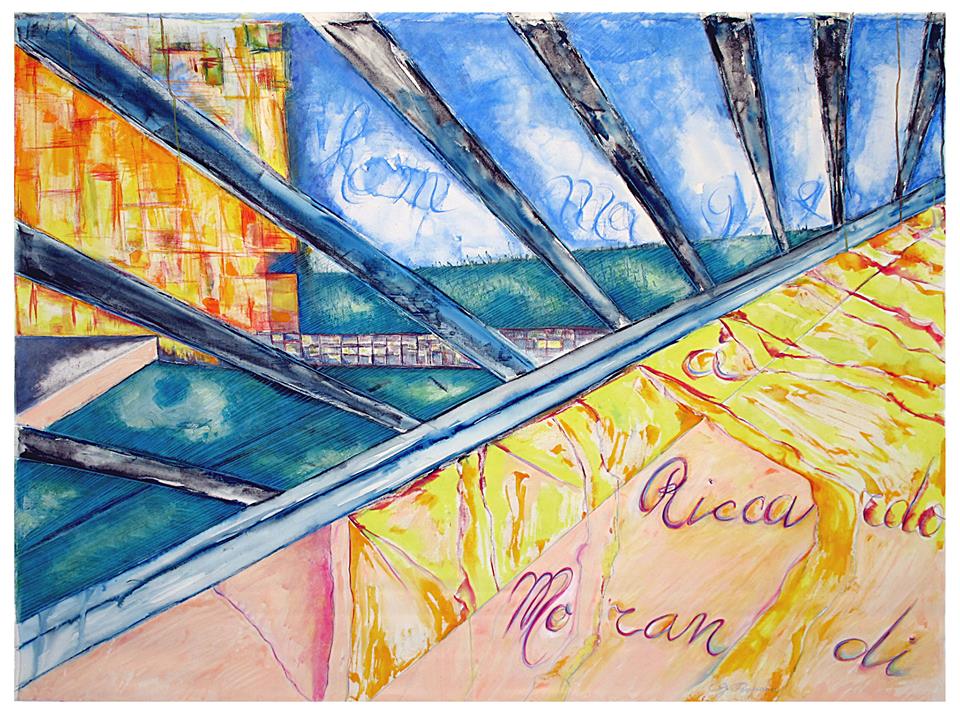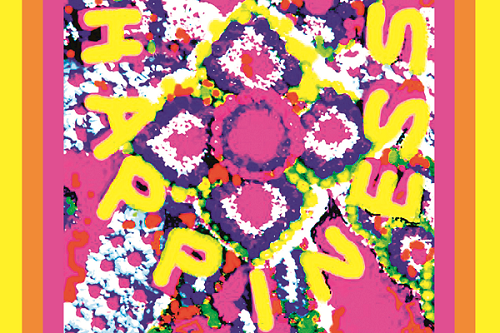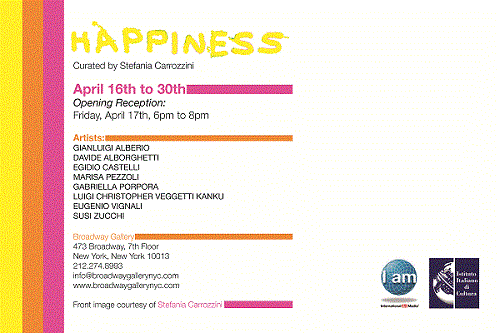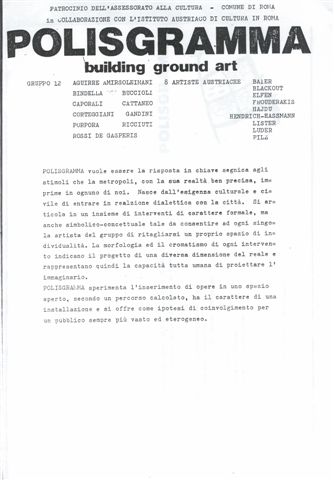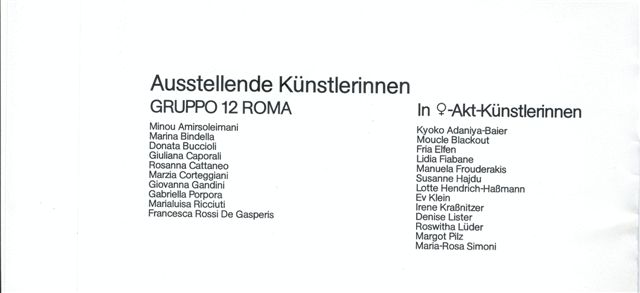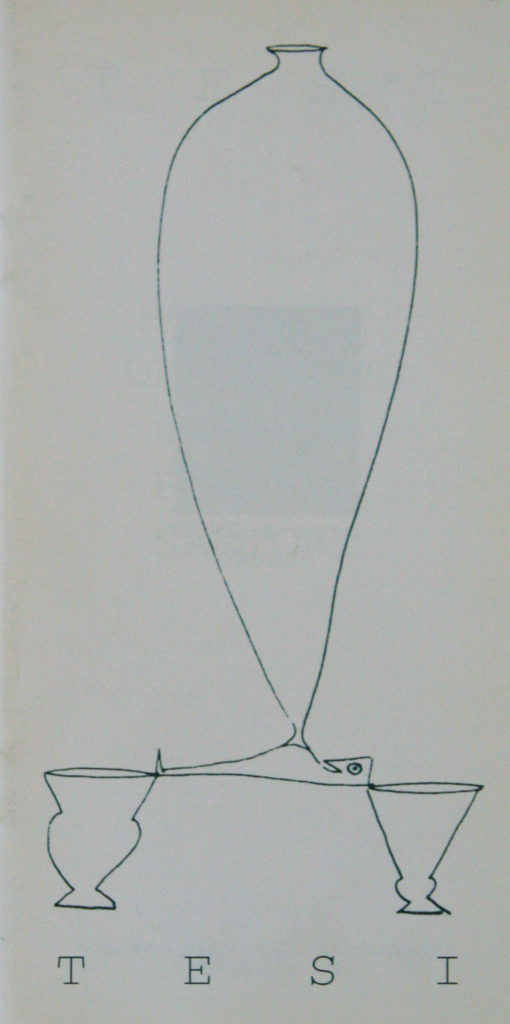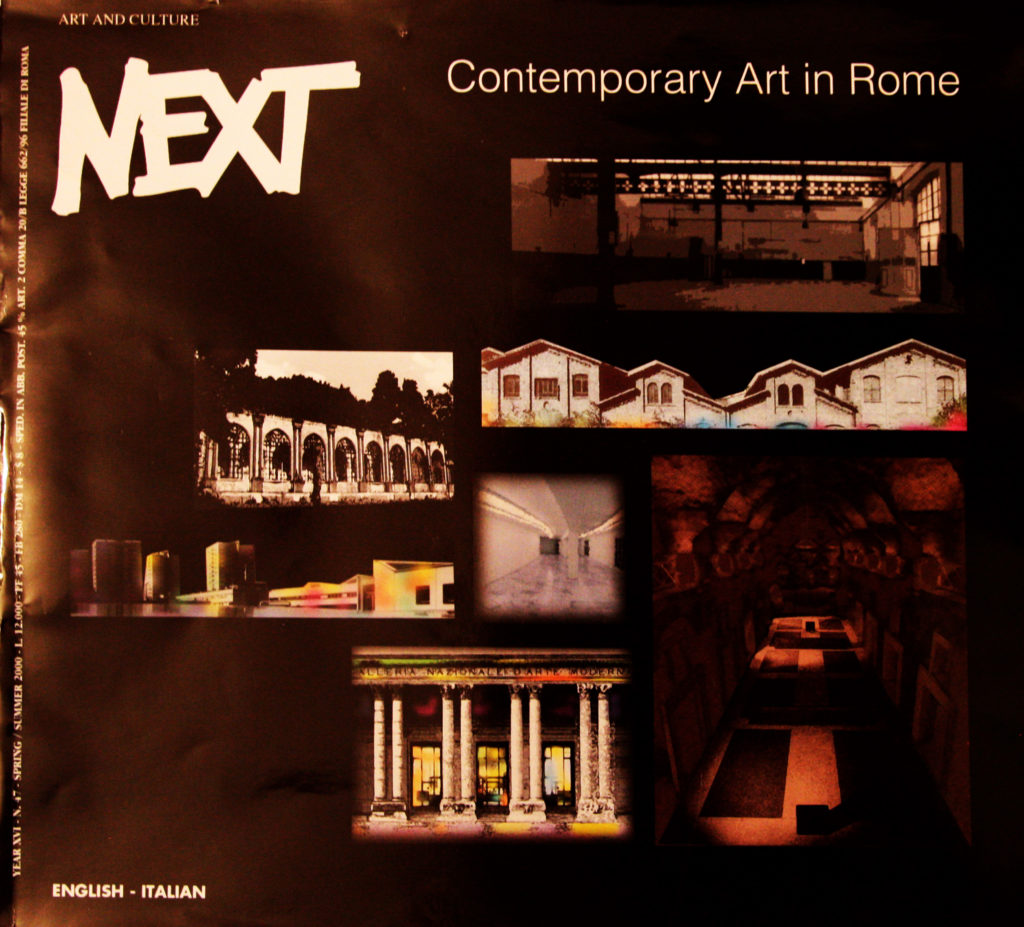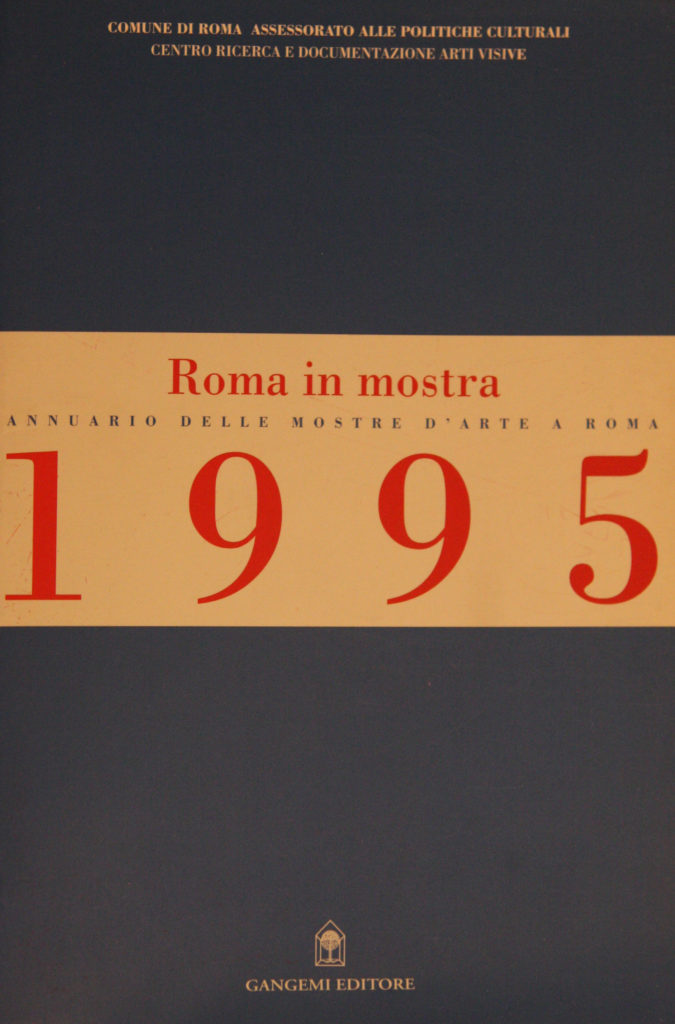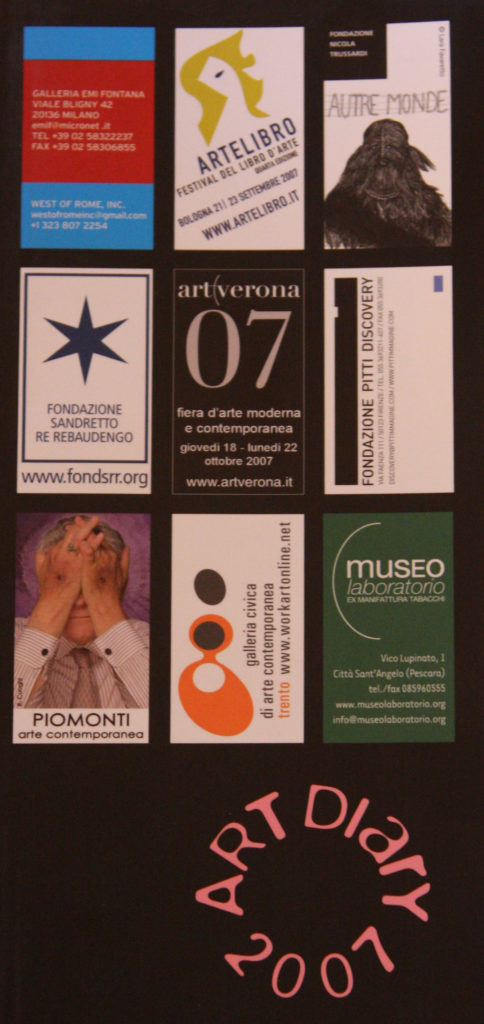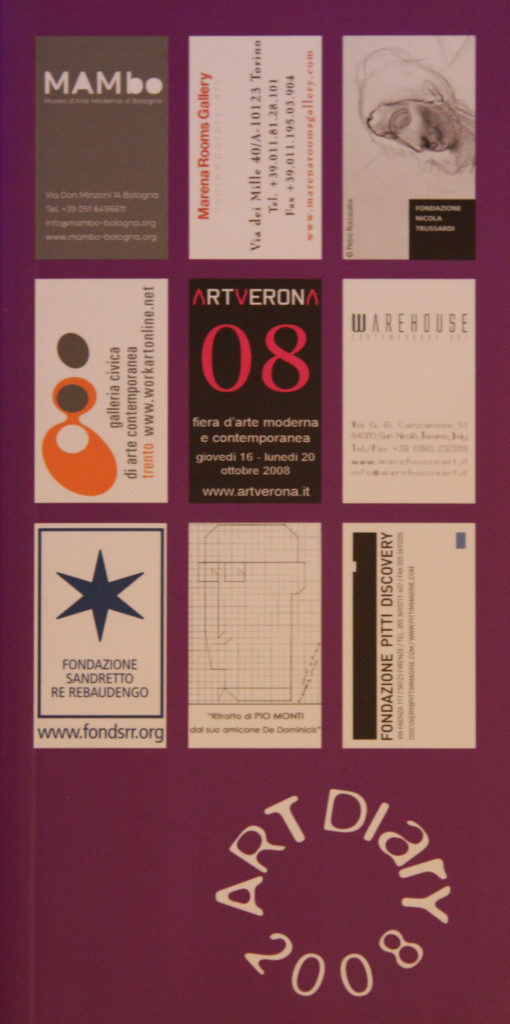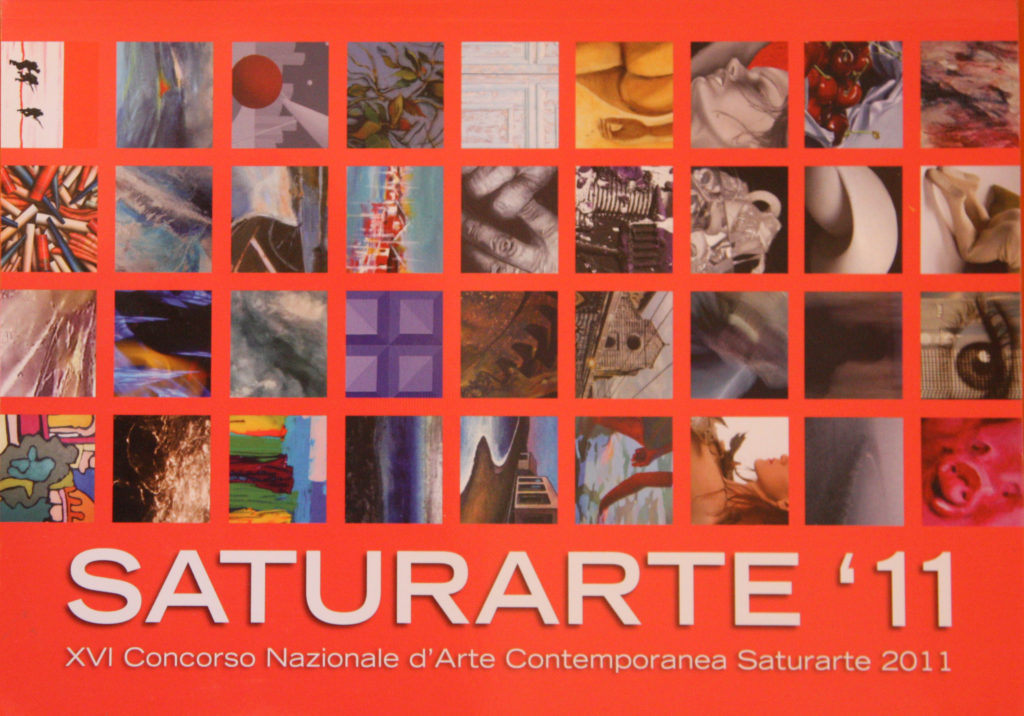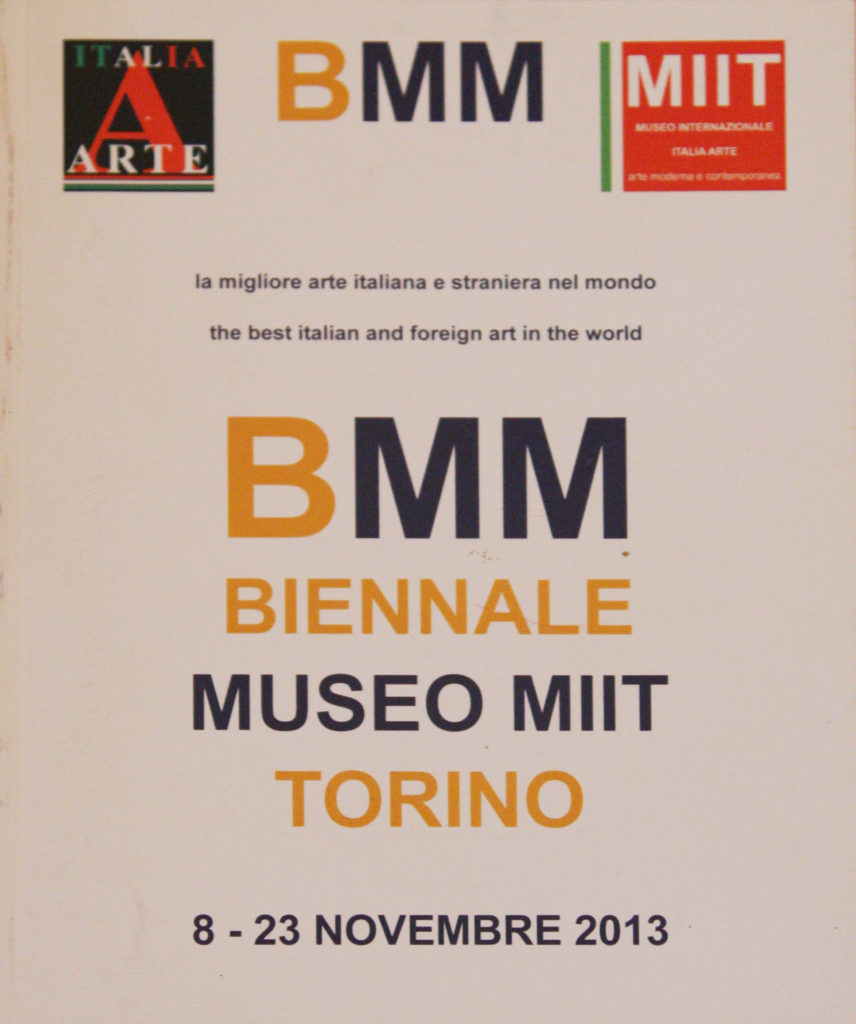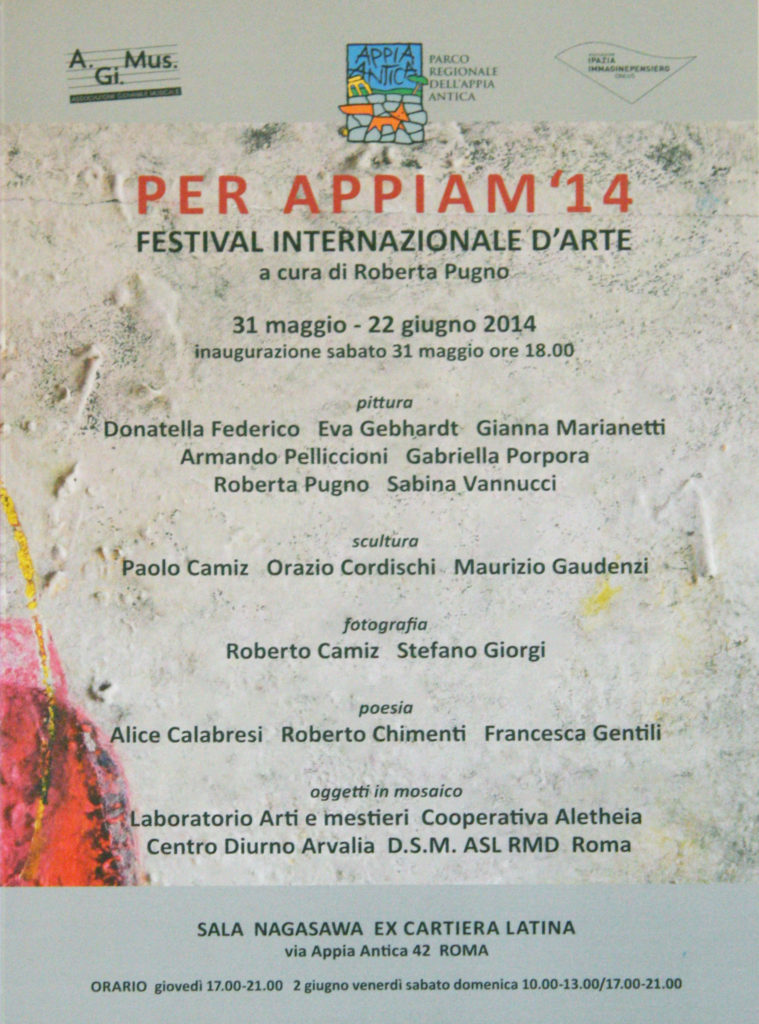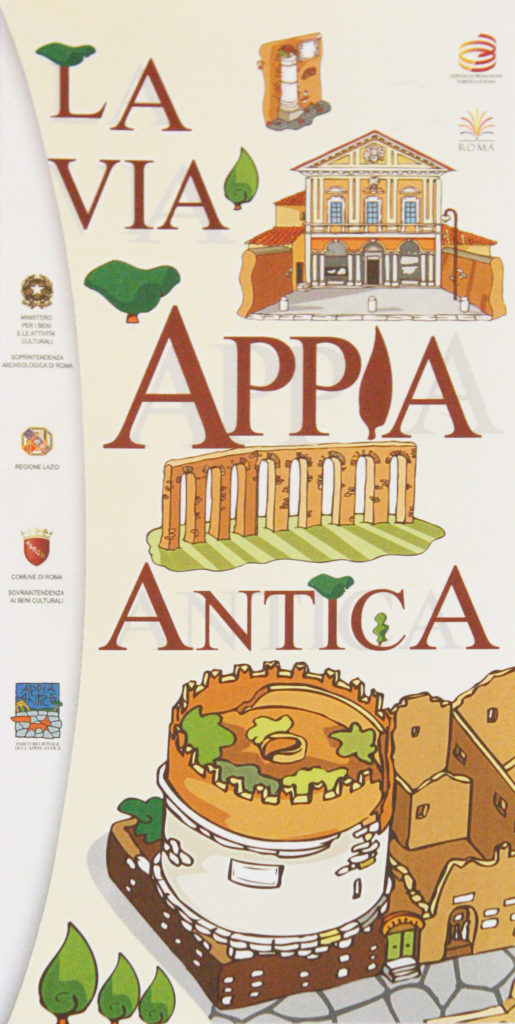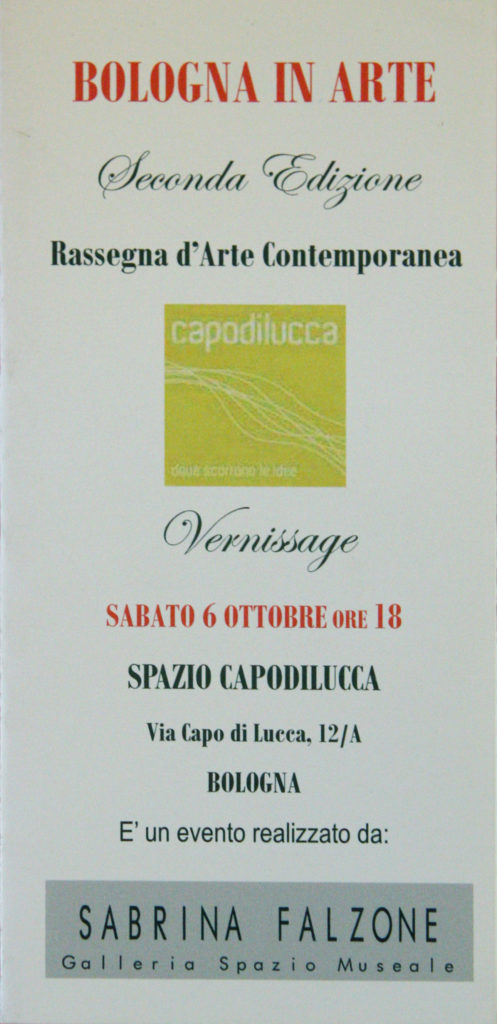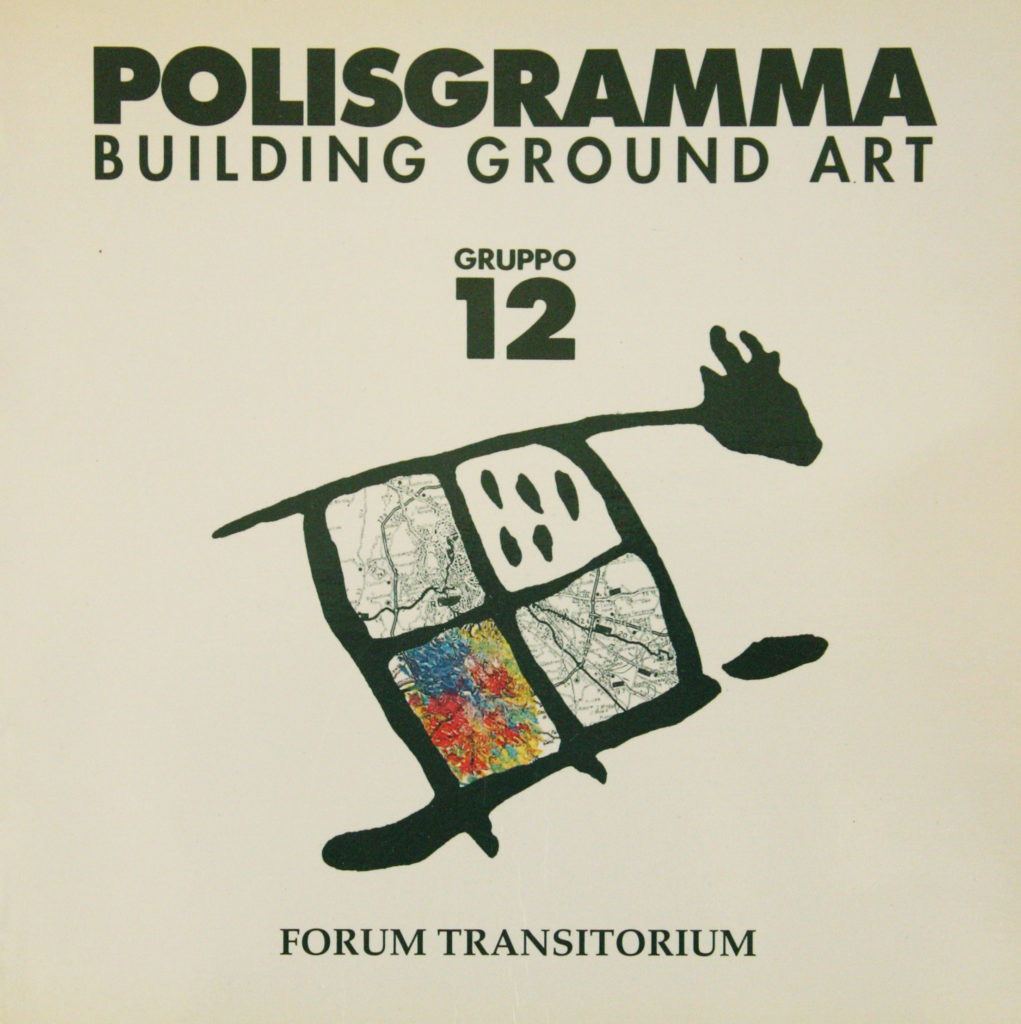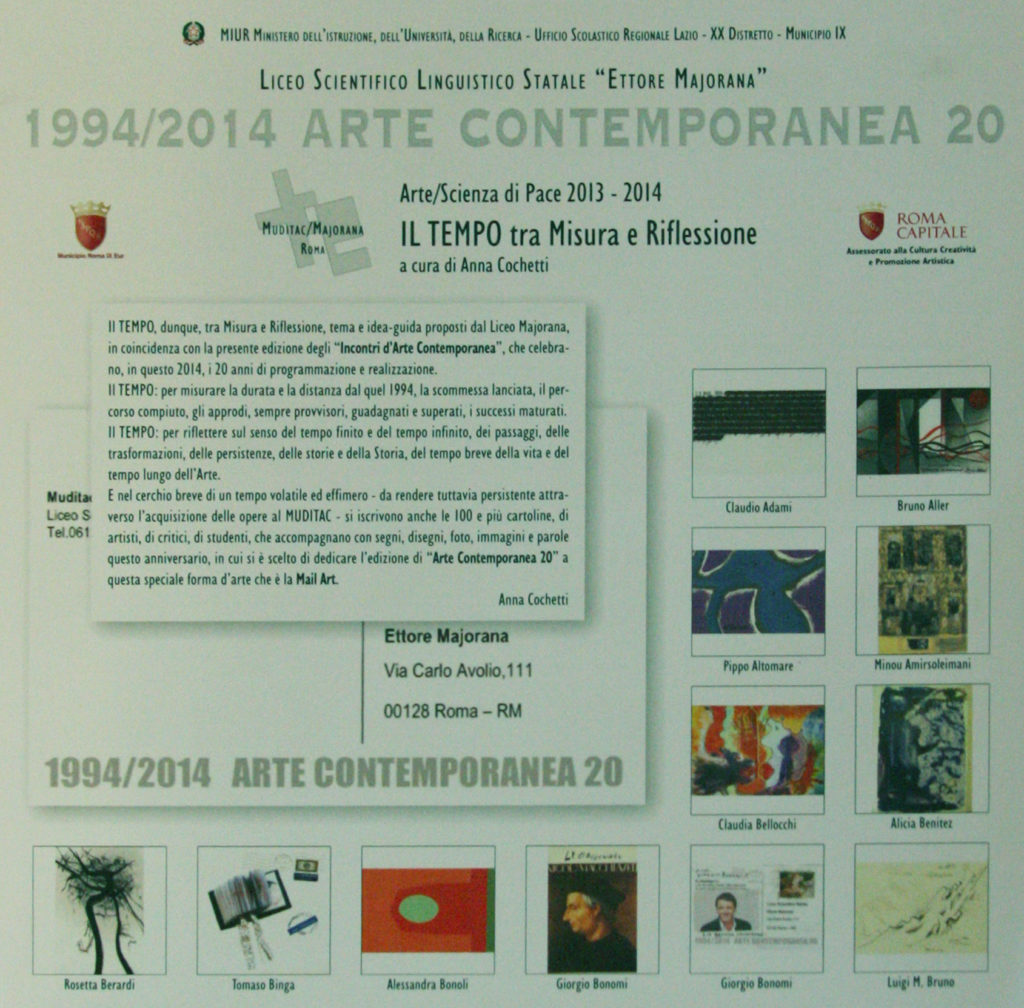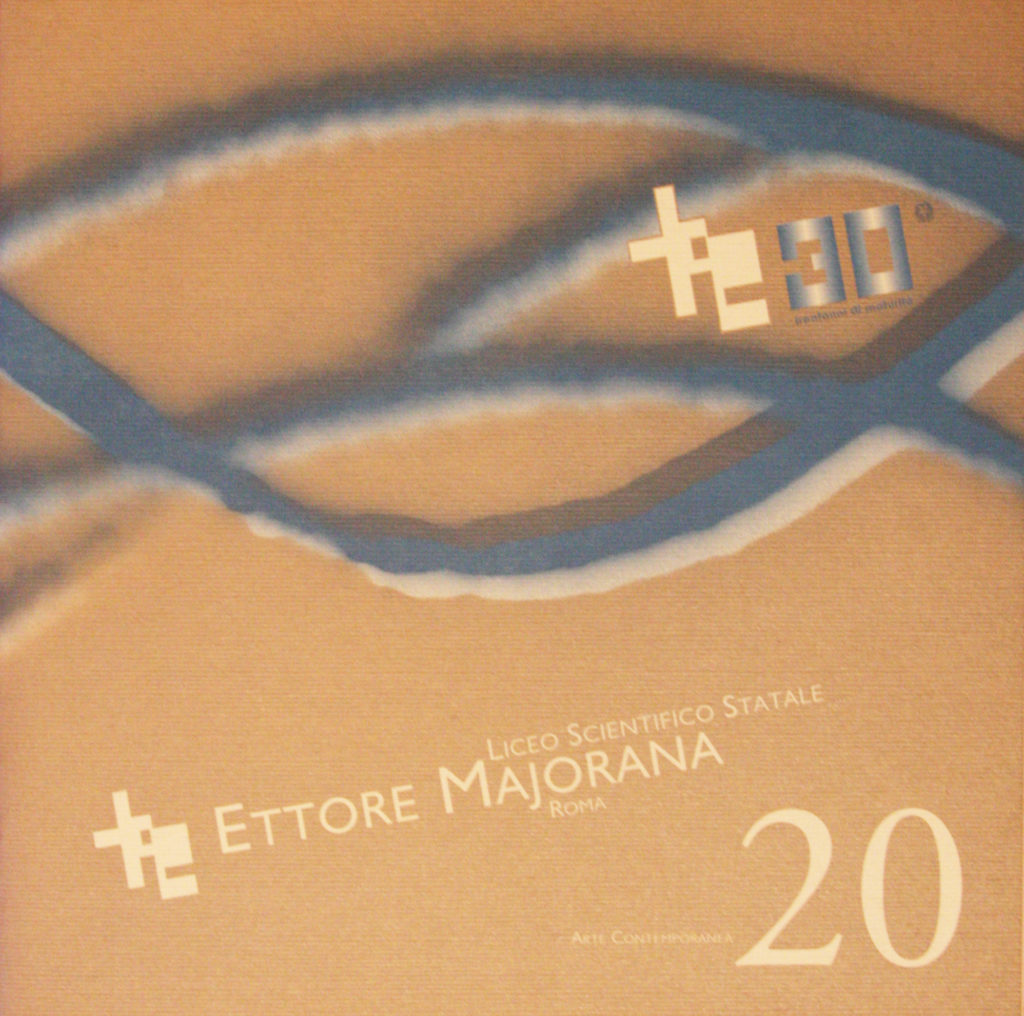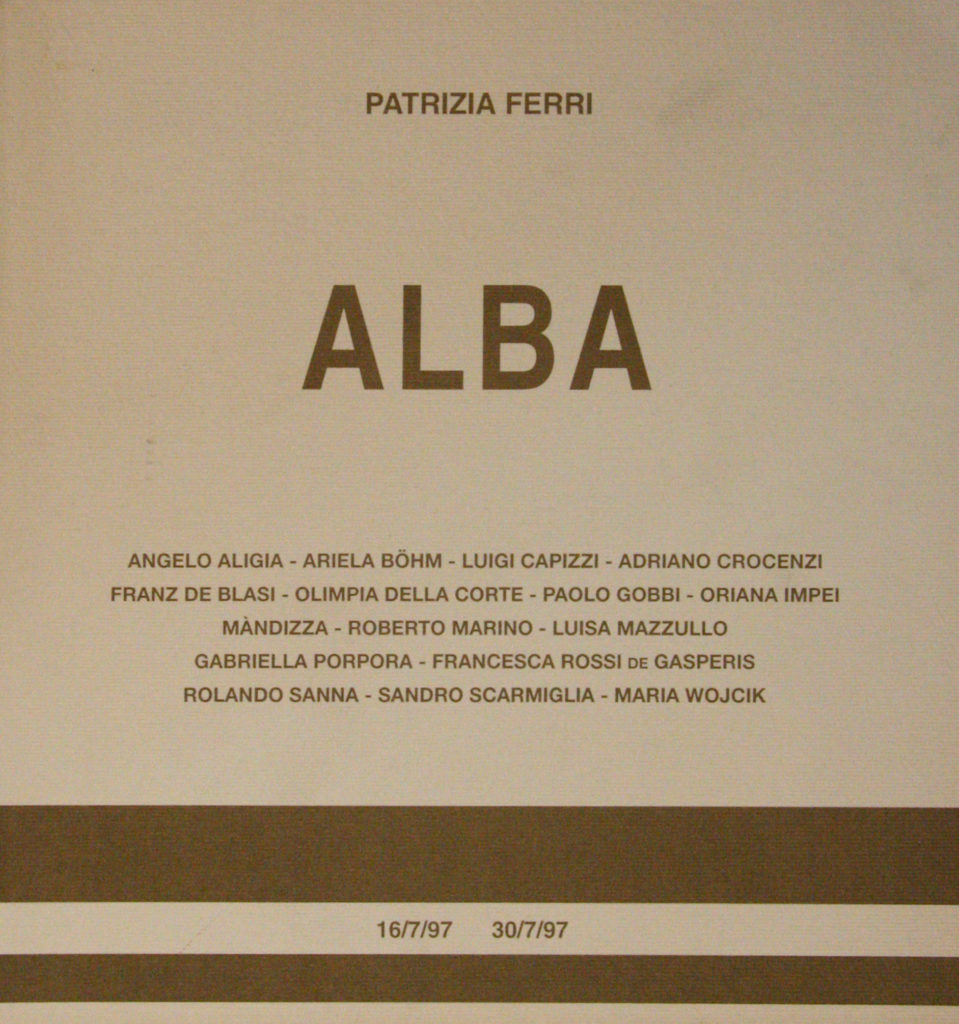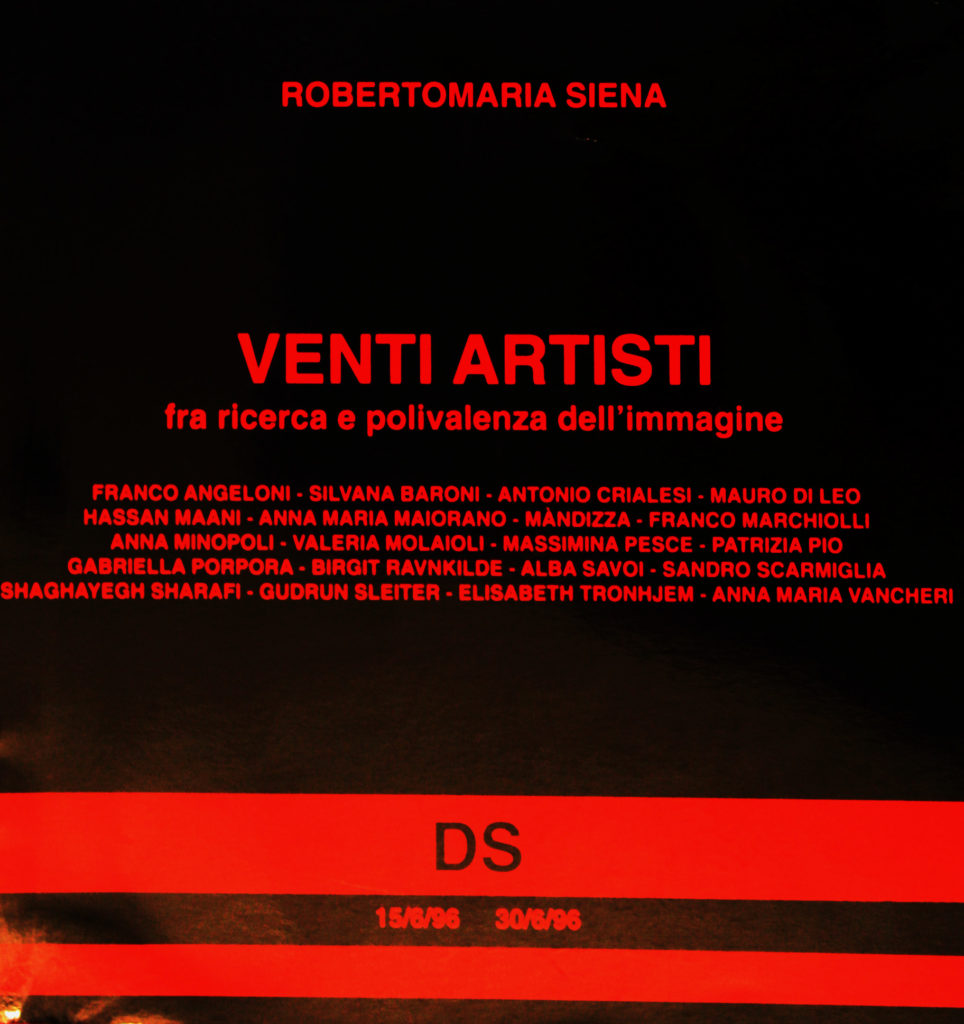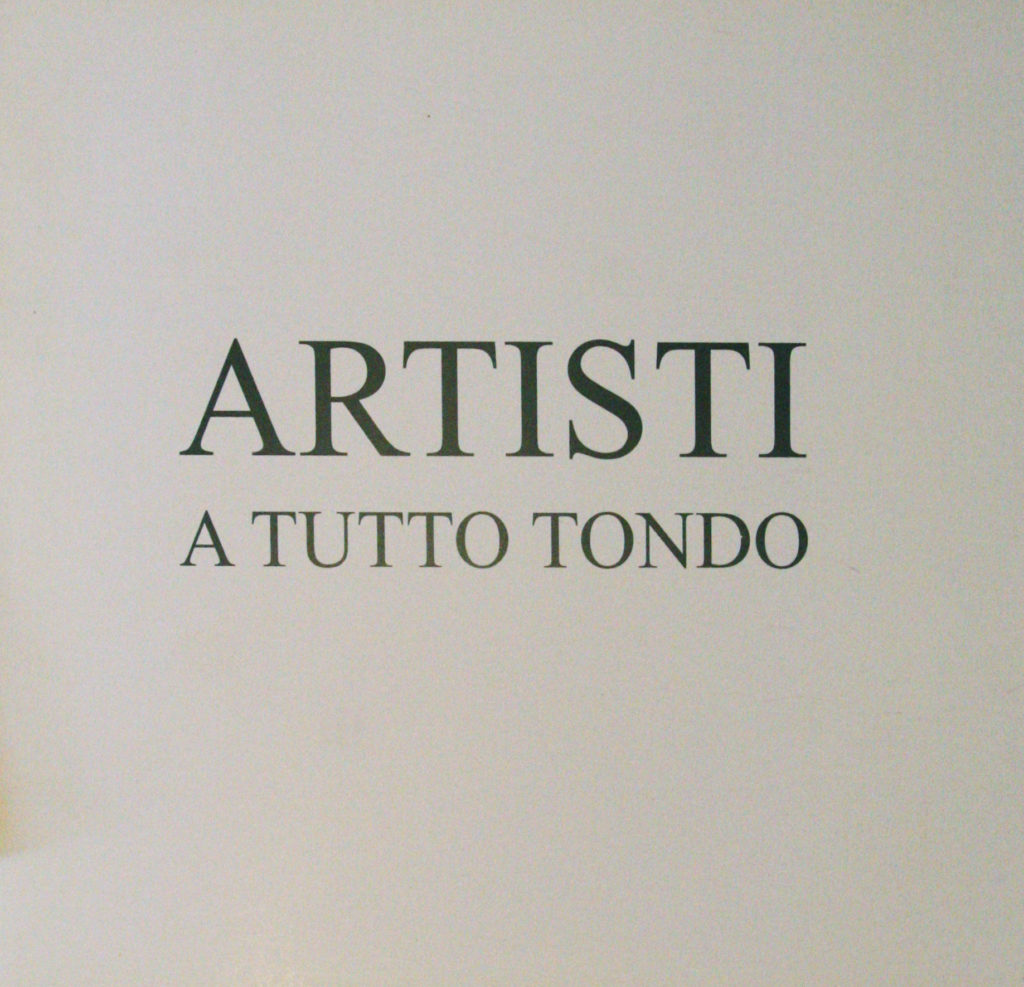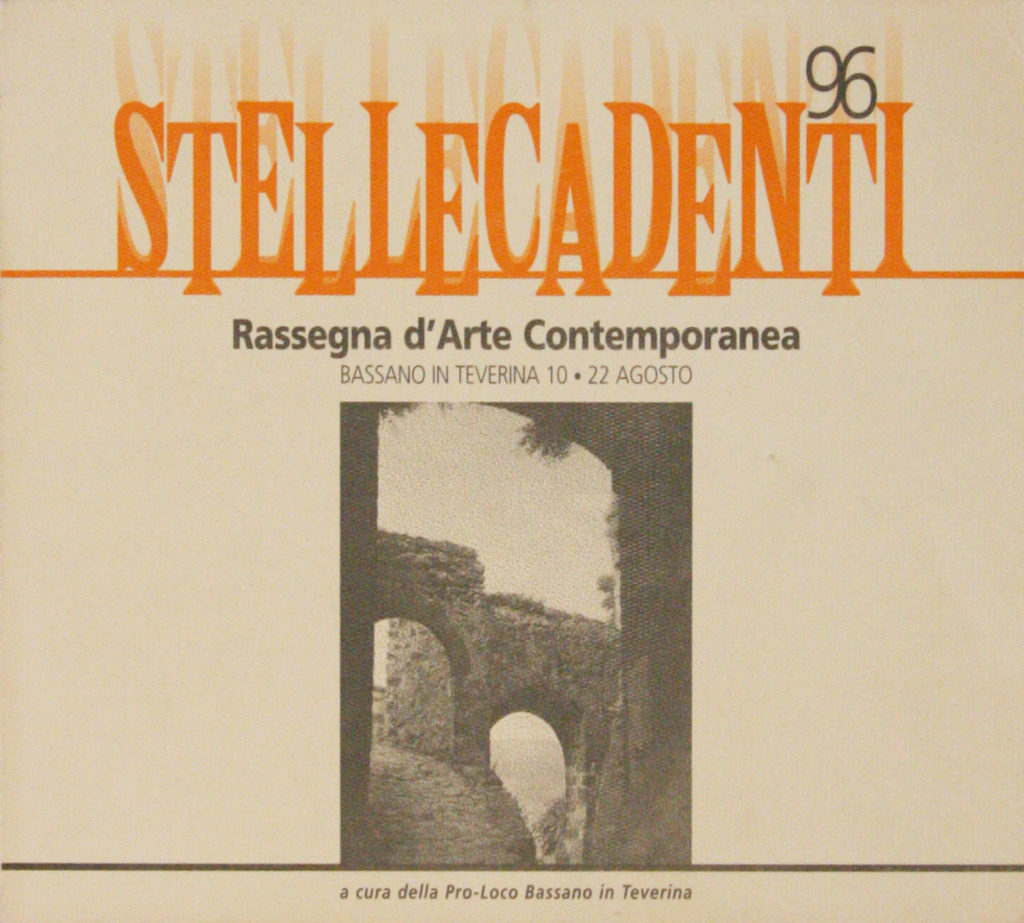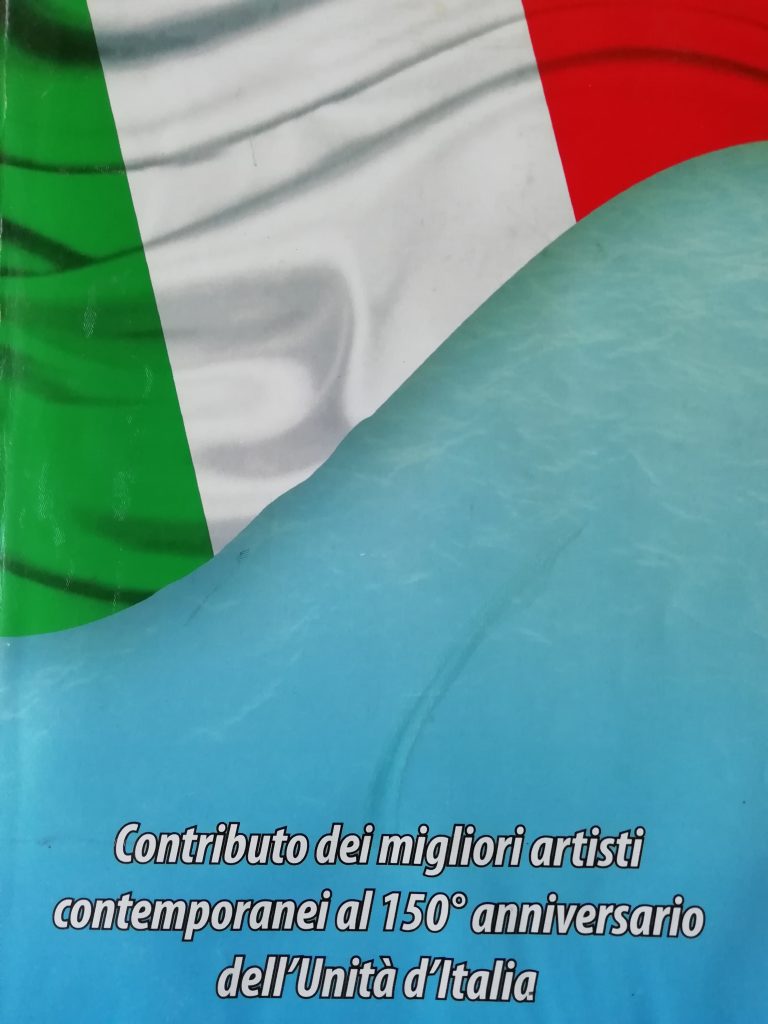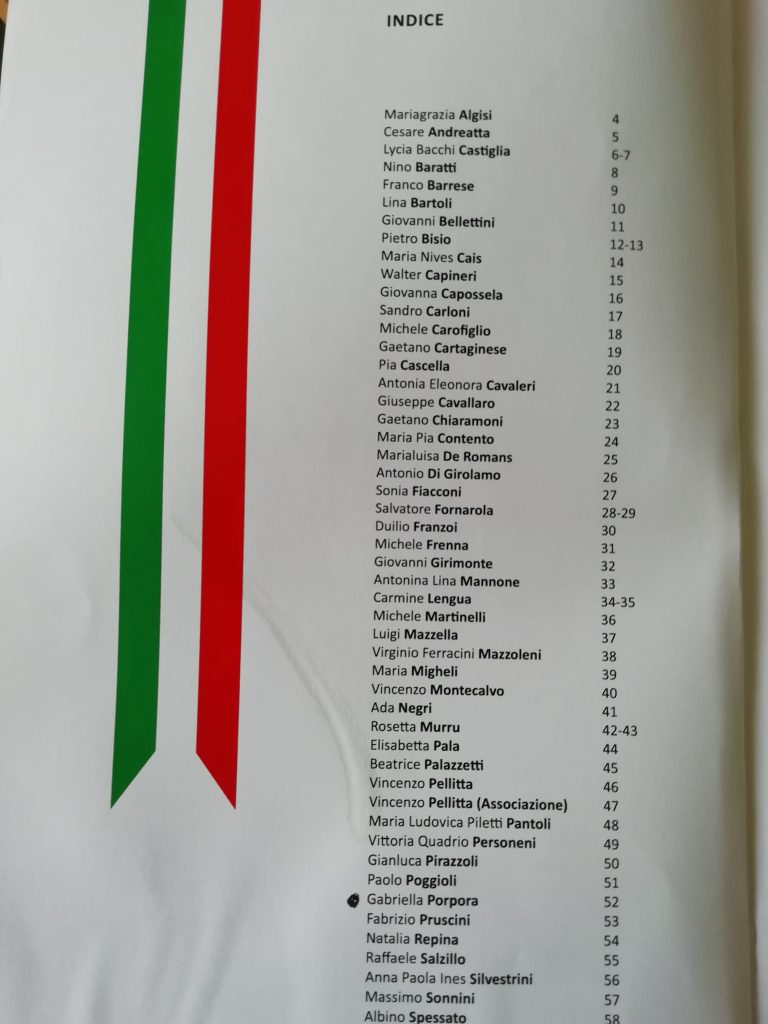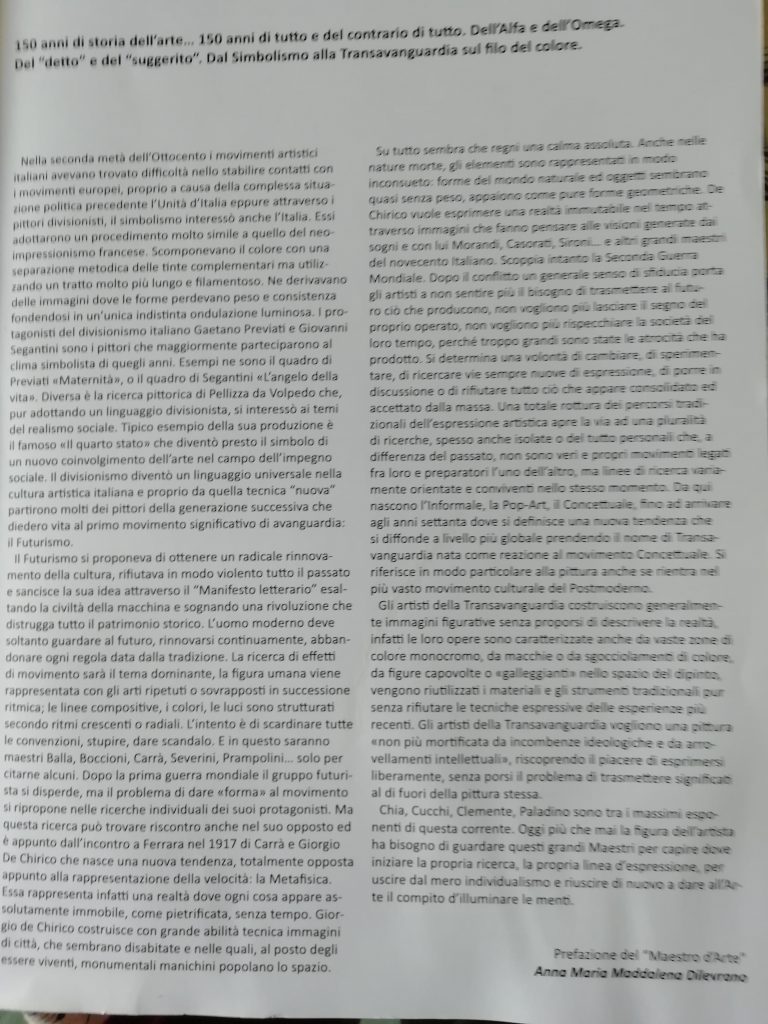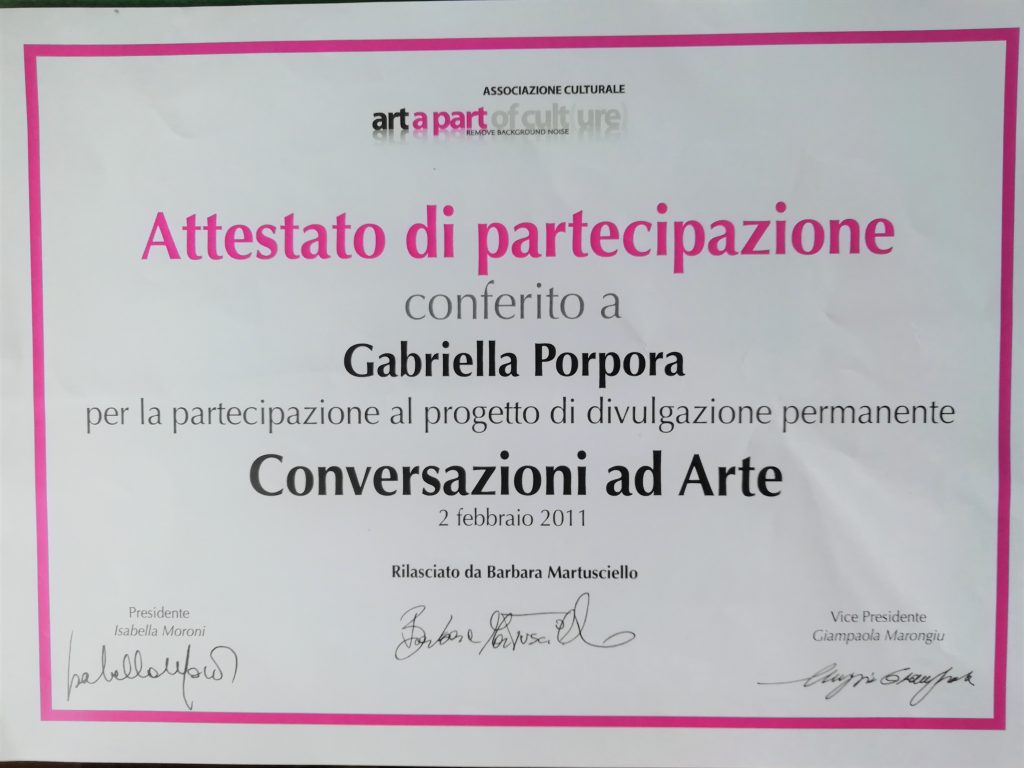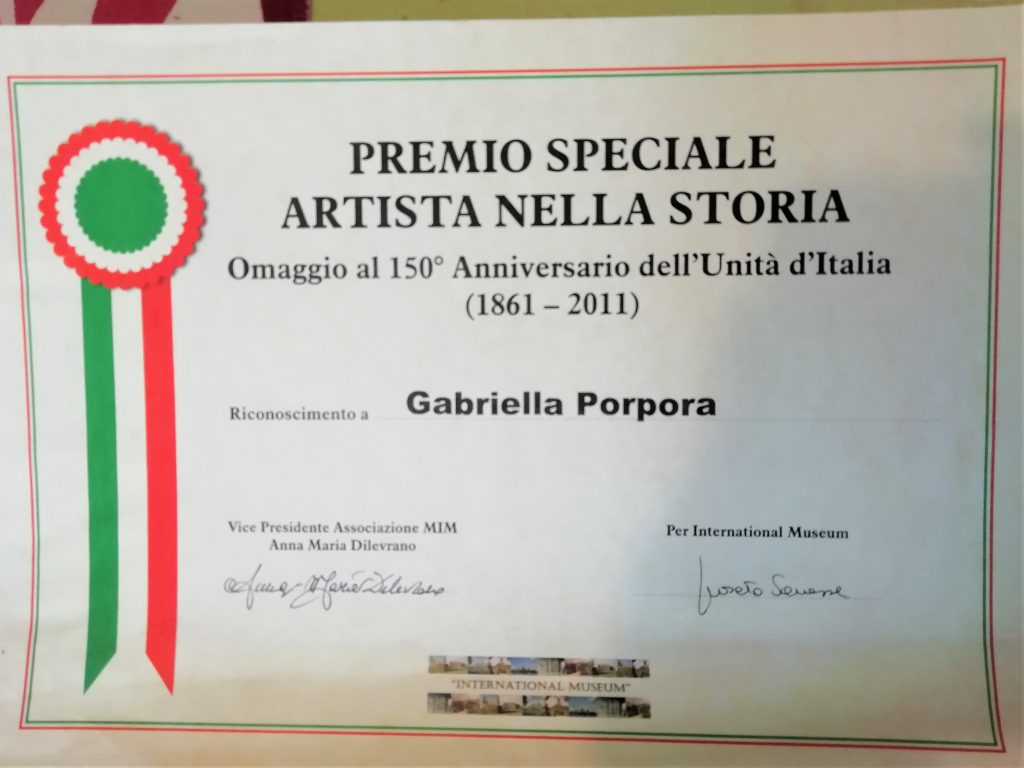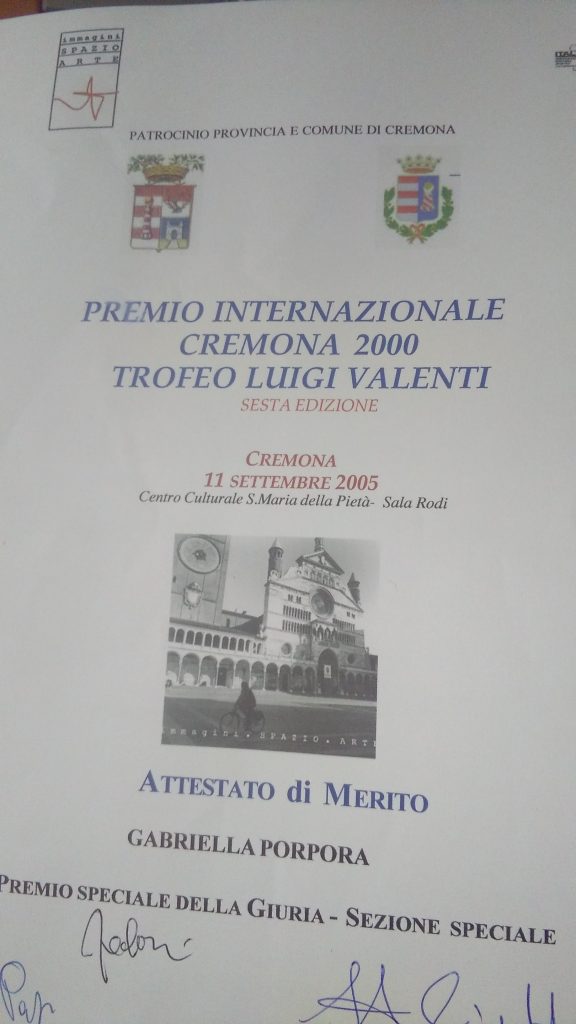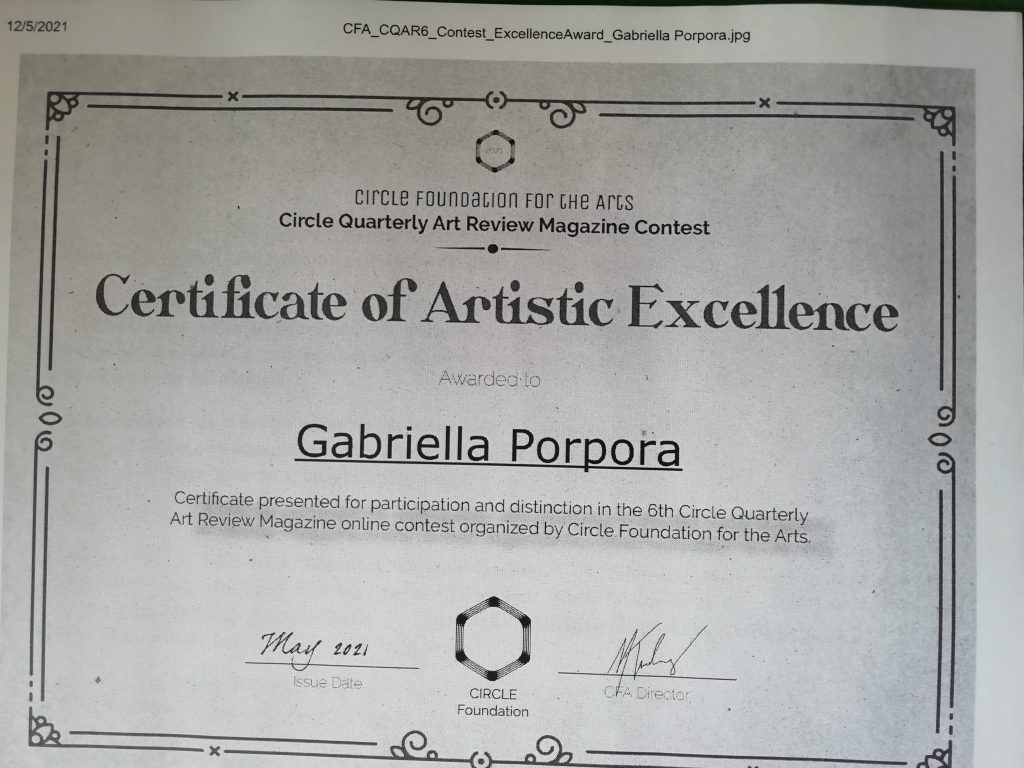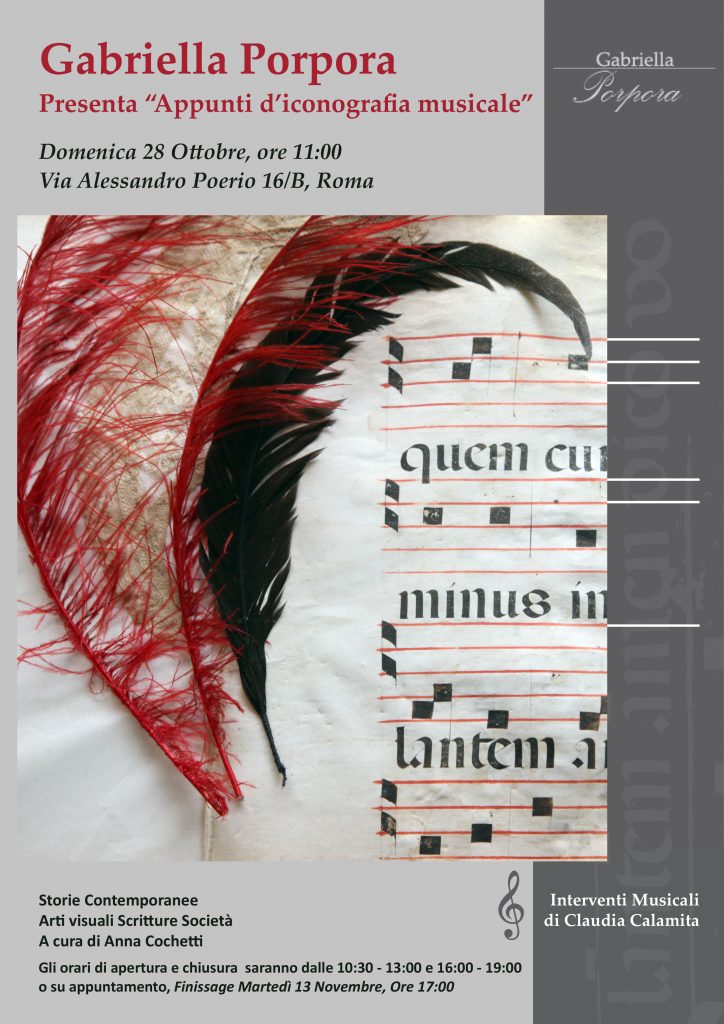Gabriella Porpora
Quest’artista viene indirizzata inizialmente in studi che non rispondono ai suoi desideri e decide rapidamente di seguire la sua inclinazione frequentando sia il Liceo Artistico, che l’Accademia di Belle Arti a Roma con Guttuso, Guccione e Montanarini.
Inizia la sua attività espositiva negli anni ’70, indagando nella memoria imponente della pittura e interrogandosi sul rapporto tra l’arte e l’essere, nella relazione tra l’uomo nella sua complessità ed il mondo circostante.
In seguito, durante la sua lunga permanenza negli anni ‘80 a Parigi, Studia Archeologia e Storia dell’Arte alla Sorbona, Paris IV, dove frequenta Artisti Italiani residenti in questa città come Licata, Del Drago, Silvestri, Pavanel.
Quest’artista colora con passioni gestuali, rende omaggio agli alberi, alla natura, non religiosamente ma concettualmente, contrastando chi vuol bruciare tutto e tutti, contro chi dimentica – emozioni-sentimenti-profumi-ragioni-speranze. Vuole “recuperare memoria”, eliminare gli errori, dipingere il futuro con “i suoni“ che solo la pittura può dare.
La pittura di Gabriella Porpora si è sviluppata e articolata negli anni dando vita a una serie di cicli pittorici e scultorei, dapprima figurativi – “Storie di manichini“, con citazioni ispirate alla metafisica di De Chirico – poi sempre più astratti , dilatando la tela in “trame metalliche“ fino ad arrivare alla “trasparenza”, dipinti su perspex, di “Geografie impossibili”, alla Galleria DI SARRO.
Partecipa a diverse iniziative di carattere culturale come Donna e Arte, Arte e Arte, Arte per… e continua ad esporre sia in Italia che all’estero, dopo il suo rientro a Roma dove attualmente risiede, guardando costantemente sia alle avanguardie artistiche che ai contemporanei.
Di ritorno dall’Africa del Sud, elabora dei lavori ispirati fortemente a queste radici, vedi “Ab Origin”, ed “Escissione” con una condanna dichiarata contro pratiche tribali ancora in uso.
Dopo una permanenza in Cina a Pechino, elabora “Derive linguistiche”, ispirandosi agli ideogrammi.
Elabora libri artistici, quadri e oggetti, usando materiali orientali come inchiostri, carte e ricordi di viaggio, che in una certa misura sono ancora in divenire.
Analogamente di ritorno dall’Africa del nord – Egitto e Marocco – si interessa alla scrittura araba, continuando ad elaborare la sua ricerca sulla trasparenza e sulle maschere.
E’ fondatrice, assieme ad altri artisti, del Gruppo Culturale POLISGRAMMA – Gruppo 12, che durerà 20 anni, con “Installazioni di grandi dimensioni“, agendo principalmente sulle recensioni delle città, per seguire un ideale di bellezza e rigore, in alternativa a spazi museali inadeguati.
Viene notata dal critico Giorgio Di Genova, che le propone l’inserimento nella Storia dell’Arte del XX secolo. Collabora inoltre con altre Associazioni Culturali come DONNA&ARTE, L’Isola che non c’è, ARX, etc.. allestendo esposizioni e illustrando anche visite guidate per la sua città di cui è innamorata.
Espone in Germania alla Galleria “ANNA FRANK”. Parteciperà successivamente ad un’altra personale invitata dalla Deutsche Bank di Wuppertal.
Alcuni suoi lavori sono ospitati ancora oggi nella “Collezione della Farnesina” al Ministero degli Esteri e presso musei come MUDITAC.
Continua ad esporre in personali e collettive in diverse città italiane Roma, Milano, Bologna, Genova, Trieste, Firenze, Tuscania, Viterbo e – all’estero – Parigi con cui intrattiene un legame stretto, Vienna, New York.
E stata invitata più volte a partecipare a delle personali presso le sedi di alcune banche italiane ed estere – BANCA NAZIONALE DEL LAVORO, BANCA SELLA.
Recentemente, erede di una tradizione familiare dedita alla musica, in cui la nonna, Elvira, è stata una soprano e la madre, Fausta, una pianista – ha inaugurato un nuovo ciclo di lavori ispirati a questo tema.
In questo “ Viaggio Musicale”, utilizza, come nel suo stile, materiali “antichi” armonizzandoli con quelli odierni in un percorso che dal passato arriva all’età contemporanea.
English version
Gabriella Porpora is a visual artist whose work, over the years, has evolved in different pictorial plastic-arts and sculptural cycles.
In the mid-eighties, during her stay in Paris, she could not avoid noticing the omnipresence of Art Nouveau. Her artistic activities thus began with her investigating how works of art impose on one’s memory; the relationship between art and human beings and their relationship with the world.
Gabriella’s initial themes were figurative. Looking for a way to evidence the extent of art development in the twentieth century, while herself living in a different time, she discovered the charm of vintage mannequins in the antiques markets and even “dumped” on the street. She took these bodies and wrapped in a metaphysical atmosphere so as to offer a new way of observing them.
Her first personal exhibition, Hors le Regard, alluding to De Chirico’s metaphysical works, was held at Galerie de l’Arbaléte in 1984, on the theme Belle Epoque and the Italian Novecento.
Being much fascinated with metaphors, which also allow observers to extrapolate different meanings from artworks, on return to Rome in 1985, she drew from the Greco-Roman myths of the city, and completed a series of wood and metal sculptures: Il Minotauro, Il Giogo di Pasifae, Dioniso, Apollo e Daphne, Prometeo.
Slowly, her themes become more abstract, expanding her canvas in a new art cycle within metal frames. In a search for transparency, the frames become more and more ethereal, a prelude to a new series of artworks.
Transparency had been on her mind since her stay in Bucharest from 1972 to 1976. There, she had seen Romanian reverse-glass, icon-painting artists who, in imitation of the more traditional wooden icons, covered glass with religious themes in an attempt to obtain the same gold and colour effects.
Instead of “divine” gilding, a medieval symbolic evocation of Paradise, Gabriella focused on the importance of the translucent weave of the glass.
Moving beyond her metal frame chapter, she decided to work on a new transparent support, Poly Methyl Methacrylate (PMMA), or plexiglass. Being less fragile and more flexible than glass, she shaped it, painted on it with a variety of colours, used special textures and different densities of matter to let the light through, while also adding symbolic materials.
She called her technique Picto-Sculpture, and the results were amazing. The light across the plexiglass shimmered and reflected on other surfaces. Even the colours reflected and expanded their influence in the surface forming a constantly moving perspective.
Città Piramide alludes to a theatrical and metaphysical space. This work was displayed in Vienna at the WUK-Offner projectarum and at the Italian Cultural Institute.
Codice Miniato is an Art Book, consisting of plexiglass pages covering different periods of art history, from the Middle Ages through to Futurism (1910-20). This book was displayed at the Biblioteca Nazionale Centrale in Rome and the last page is an interpretation of the Depero landscape of New York!
In Enluminures, Gabriella’s purpose was to underline the preciousness of signs such as calligraphy. To stimulate an association with illuminated manuscripts that are the purveyors of text embellishment and proof of important past human activity, here and there in this work, she added antique parchments.
In another Art Book, Carnet de Voyage, as one’s gaze flows across the pages, the colours suggest paths in making, a mix of new and old landscapes and prospected spaces.
Attracted by the geographic maps that she saw when was younger, she started drawing and re-using maps, collecting and recreating little by little, a whole new wonderful world.
The ductility of PMMA allowed her to imagine and create different landscapes. Geografie Impossibili was displayed at the DI SARRO Gallery, a contemporary art documentation centre, under the supervision of critic-curator Gabriella D’Alesio.
Drawing inspiration from a trip to Africa, and employing some original materials from this continent, she elaborated new sculptures, Ab Origin and Contro, the first questioning the origin of mankind, the second, shaming ongoing tribal practices such as infibulation and excision of the clitoris.
n the early nineties, with a group of women artists, Gabriella cofounded Polisgramma – Gruppo 12, and began a period of collective assemblies and interventions in the city of Rome.
Her social commitment become explicit while working with this civic interest group. To highlight the continuous metamorphosis of the city, the group created Building Ground Art.
The group’s intervention was of social and aesthetic importance: to offer a different space for the Polis and emphasize the necessity to preserve both the material and the immaterial.
They chose metal fences of urban constructions to showcase these objectives. The fences, beyond being an ideal support for the group’s artworks, become symbols of the city’s transformation: ideal places for memory, imagination and art; original spaces for the artists and an alternative to museums. Further details of this social commitment can be found on Gabriella’s personal website.
In the meanwhile, Gabriella continued to use or recycle plastic materials to produce her artwork. She held numerous exhibitions in different towns, with public patronage and curated by Anna Cochetti.
Some of these were: Questa non è una città at the Biblioteca Nazionale Centrale; La dea Roma at the Termini Station in Rome; Le Radici del Tempo at Rome’s Imperial fora; Aspetti della gerarchia immaginifica, at the Politecnic of Milan; L’ondata burocratica tenta di travolgerci tutti, for Follia Urbana at Palazzo degli Alessandri in Viterbo.
A new artistic adventure began after a stay in Beijing. Fascinated by Chinese ideograms, Gabriella began painting and creating a series of masks and art books. She employed authentic materials such as inks, papers, kites, masks and travel souvenirs, and played with the comparison of civilization “metaphors” that sprung up from these works. This series led to a personal exhibition, Derive linguistiche, at the Gallery l’Ariete, curated by Valerio Dehò.
Being heir to a family tradition devoted to music, her grandmother, Elvira, having been a soprano and her mother, Fausta, a pianist, music, considered the form of abstract art for excellence, become her next inspiration to employ symbolic ways to create visual abstract “musical” performances.
Only in the 1600s had a way of conveying music by means of symbols, been elaborated. This would not have come about had human beings not listened, and heard that sound “travelled” inside of them, and made them vibrate like musical instruments.
At a vintage market Gabriella found some old rolls of piano music; continuous rolls of paper with perforations for the musical notes and music terminology such as incipit, andante, mosso, piano, ritmo and allegro. She sensed that these rolls were the perfect material to incorporate in her artwork to provide iconographic reference to music and she went ahead and inaugurated a cycle of artworks on this theme.
To signify classical music and call this historical period to mind, she added small details to the piano rolls and applied the rolls in structural assemblages, that move in alternative rhythms, on the surface of her paintings.
Through these artworks, Gabriella introduced an “antiphonary”, again emphasizing the importance of not forgetting one’s roots while creating something new.
This series, entitled Appunti d’iconografia musicale, was displayed at the Gallery Studio Storie Contemporanee and curated by Anna Cochetti.
Throughout her artistic career, Gabriella Porpora has conveyed, by means of all she embodies in her creative works, both emotional and rational stimuli that resonate in the imagination and allow viewers to participate in a universal game.
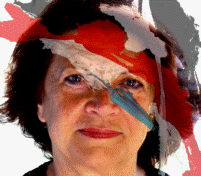
Il desiderio di ricerca è in divenire, perché questo è il suo modo di essere.
L’essenzialità delle pitture rupestri, il rigore e il simbolismo medievale, il disegno e l’anatomia rinascimentali, la linea barocca, la ricerca luministica degli impressionisti, quella coloristica dei Fauves, l’atmosfera della Metafisica e del Surrealismo, la spiritualità dell’Astrattismo e la matematicità dell’Informale, alla ricerca di un segno, di un linguaggio e di uno spazio personali.
“E certo alla mente e al cuore parlano le opere di Gabriella Porpora, fluttuando dense e colorate come nebulose in un cielo trasparente senza inizio e senza fine, proprio come noi percepiamo l’universo e come forse ci illudiamo che siamo noi stessi: senza un inizio e, soprattutto, senza una fine.”
“It’s the particular blue hue that Gabriella Porpora has chosen for her monocrhomatique painting on plexiglass “ Ritmo di danza” that make one think of Yves Klein, the French avant-gardist who covered nude women in paint and created compositions by rolling and dragging them across huge canvases laid out on the floor. […] Once again the viewer has no choice but to surrender, letting a smile be his or her umbrella.”
“Sopra tutto, prevale un senso di luminosità e di trasparenza, tanto cercato da ricorrere all’uso del perspex, attraversato da toni cromatici e da umori culturali.”
“Il suo far proprio un linguaggio lontano geograficamente ma non spiritualmente, rende chiaro il senso di un operare artistico che prova di stabilire punti di contatto, che cerca nell’attrito delle derive linguistiche di provocare quello stupore che ogni genuina conoscenza dovrebbe produrre.”
“Gabriella Porpora con fusioni materiche esprime polivalenze di significati e di forme in strutture di passionalità coloristica.”
“Il materiale usato acquista propria autonoma valenza decorativa […] fratture o assemblaggi materici coniugano colore e materia sempre in sospensione e in chiave di poetiche visioni.”

